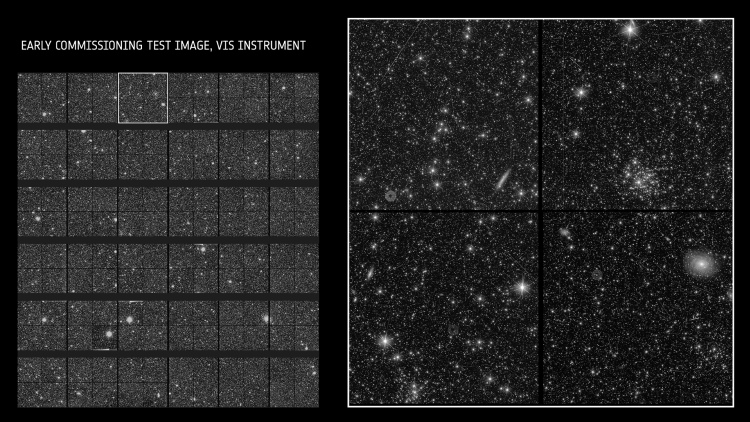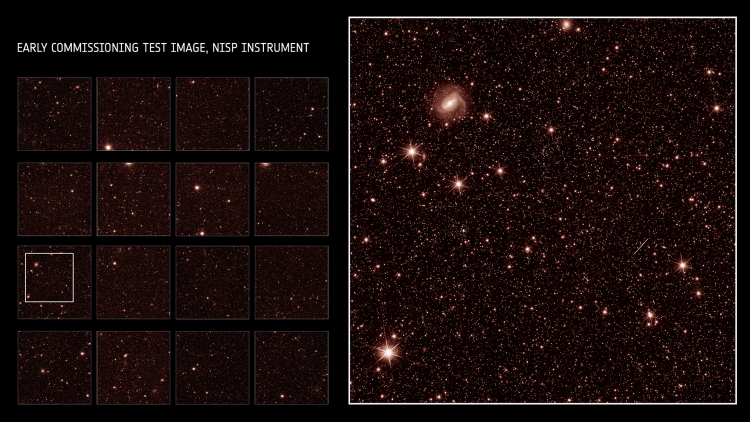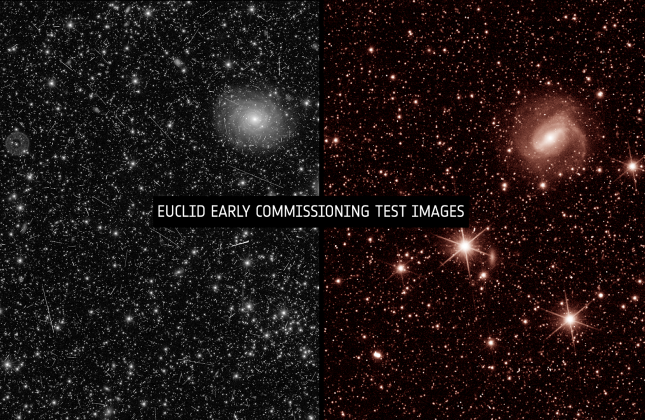Although there are months to go before Euclid will unfold its new view of the cosmos, reaching this milestone means that the scientists and engineers behind the mission can be confident that the telescope and instruments are working well. 'After more than 11 years of designing and developing Euclid, it is exhilarating and emotional to see these first images,' says Euclid project manager Giuseppe Racca (ESA). ' It’s even more incredible when we think that we see just a few galaxies here, produced with minimum system tuning. he fully calibrated Euclid will ultimately observe billions of galaxies to create the biggest ever 3D map of the sky.’
The universe in visible light
Euclid's VISible instrument (VIS) will take super-sharp images of billions of galaxies to measure their shape. With the VIS image, scientists will get their first glimpse; while a few galaxies are very easy to spot, many more are fuzzy blobs hidden among the stars, waiting to be unveiled by Euclid in the future. Although the image is very detailed, the sky surface covers only a quarter of the width and height of the full moon. That is one millionth of the total area of the sky that Euclid will map over the next six years.

Credit: ESA/Euclid/Euclid Consortium/NASA, CC BY-SA 3.0 IGO
The image is even more special considering that the Euclid team was given a scare when they first switched the instrument on: they picked up an unexpected pattern of light contaminating the images. Follow-up investigations indicated that some sunlight was creeping into the spacecraft, probably through a tiny gap; by turning Euclid the team realised that this light is only detected at specific orientations, so by avoiding certain angles VIS will be able to fulfil its mission. This image was taken at an orientation where the sunlight was not an issue.
The universe in infrared light
Euclid's Near-Infrared Spectrometer and Photometer (NISP) instrument has a double role: imaging galaxies in infrared light and measuring the amount of light that galaxies emit at various wavelengths. This second role lets us directly work out how far away each galaxy is.

Credit: ESA/Euclid/Euclid Consortium/NASA, CC BY-SA 3.0 IGO
By combining distance information with that on galaxy shapes measured by VIS, we will be able to map how galaxies are distributed throughout the Universe, and how this distribution changes over time. Ultimately, this 3D map will teach us about dark matter and dark energy.
Excited
'These are beautiful pictures - and this is just the beginning,' says Henk Hoekstra (Leiden University). 'We are therefore delighted! Especially after the initial shock when VIS saw a higher background. Fortunately, a solution was quickly found. For weak-lensing measurements, the sharp images are even more important than the low background, so it is great to see that we are achieving the required sharpness over the whole field.' Koen Kuijken (Leiden University) continues: 'Now we have to wait for the survey to begin, but based on these first images we expect to discover a lot about the distribution of dark matter in the universe, with the deep infrared images also helping to determine distances to galaxies.'
Test images
The images published today are early test images, taken to check the instruments and review how the spacecraft can be further tweaked and refined. Because they are largely unprocessed, some unwanted artefacts remain - for example cosmic rays shooting straight accross. The Euclid Consortium ultimately turn the longer-exposed survey observations into science-ready images that are artefact-free, more detailed, and razor sharp.
Over the next few months, ESA and industry colleagues will carry out all the tests and checks needed to ensure Euclid works as well as possible. At the end of this ‘commissioning and performance verification phase’, the real science begins. At that point, ESA will release a new set of images to demonstrate what the mission is capable of.
ESA's Euclid Blog
Dutch contribution to Euclid (in Dutch)
Euclid Consortium
